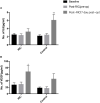Safety and efficacy of remote ischemic conditioning in adult moyamoya disease patients undergoing revascularization surgery: a pilot study
- PMID: 37576009
- PMCID: PMC10419176
- DOI: 10.3389/fneur.2023.1200534
Safety and efficacy of remote ischemic conditioning in adult moyamoya disease patients undergoing revascularization surgery: a pilot study
Abstract
Background and purpose: Revascularization surgery for patients with moyamoya disease (MMD) is very complicated and has a high rate of postoperative complications. This pilot study aimed to prove the safety and efficacy of remote ischemic conditioning (RIC) in adult MMD patients undergoing revascularization surgery.
Methods: A total of 44 patients with MMD were enrolled in this single-center, open-label, prospective, parallel randomized study, including 22 patients assigned to the sham group and 22 patients assigned to the RIC group. The primary outcome was the incidence of major neurologic complications during the perioperative period. Secondary outcomes were the modified Rankin Scale (mRS) score at discharge, at 90 days post-operation, and at 1 year after the operation. The outcome of safety was the incidence of adverse events associated with RIC. Blood samples were obtained to monitor the serum concentrations of cytokines (VEGF, IL-6).
Results: No subjects experienced adverse events during RIC intervention, and all patients could tolerate the RIC intervention in the perioperative period. The incidence of major neurologic complications was significantly lower in the RIC group compared with the control group (18.2% vs. 54.5%, P = 0.027). The mRS score at discharge in the RIC group was also lower than the control group (0.86 ± 0.99 vs. 1.18 ± 1.22, P = 0.035). In addition, the serum IL-6 level increased significantly at 7 days after bypass surgery in the control group and the serum level of VEGF at 7 days post-operation in the RIC group.
Conclusion: In conclusion, our study demonstrated the neuroprotective effect of RIC by reducing perioperative complications and improving cerebral blood flow in adult MMD patients undergoing revascularization surgery. Thus, RIC seems to be a potential treatment method for MMD.
Clinical trial registration: ClinicalTrials.gov, identifier: NCT05860946.
Keywords: complications; modified Rankin Scale (mRS); moyamoya disease; remote ischemic conditioning; revascularization surgery.
Copyright © 2023 Yang, Hu, Gao, Su, Jiang, Yang, Zhang, Ni and Gu.
Conflict of interest statement
The authors declare that the research was conducted in the absence of any commercial or financial relationships that could be construed as a potential conflict of interest.
Figures



References
-
- Ishikawa T, Kamiyama H, Kuroda S, Yasuda H, Nakayama N, Takizawa K. Simultaneous superficial temporal artery to middle cerebral or anterior cerebral artery bypass with pan-synangiosis for Moyamoya disease covering both anterior and middle cerebral artery territories. Neurol Med Chir. (2006) 46:462–8. 10.2176/nmc.46.462 - DOI - PubMed
-
- Cheung MMH, Kharbanda RK, Konstantinov IE, Shimizu M, Frndova H, Li J, et al. . Randomized controlled trial of the effects of remote ischemic preconditioning on children undergoing cardiac surgery: first clinical application in humans. J Am Coll Cardiol. (2006) 47:2277–82. 10.1016/j.jacc.2006.01.066 - DOI - PubMed
Associated data
LinkOut - more resources
Full Text Sources
Medical

